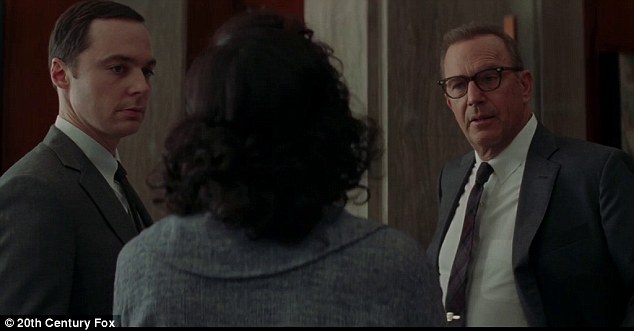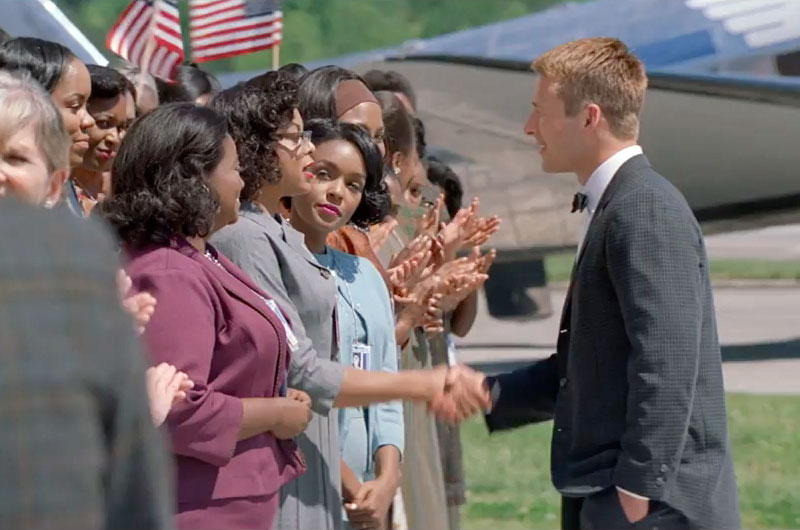Shale
Bluelighter
Hidden Figures
Movie Blurb by Shale
December 28, 2016
Poster

Today I saw another movie, based on a true story from my lifetime in the 1960s. I remember the setting of the racist, segregated South. I saw the "colored restrooms" and "colored drinking fountains," of our American Apartheid that is now and forevermore, like the slavery before it a national embarrassment. But, despite these obstacles this story is about 3 black women who along with many others behind the scenes helped NASA get out space program off the ground.
I remember the events of NASA, remember Alan Shepard's brief sub-orbital flight in May 1961 as we listened to it on the speakers in our high school classrooms. We in Overland Missouri were particularly interested in the Mercury capsule flights at this time since many of our parents like my stepfather worked McDonnell Aircraft Corp. where these capsules were made. So, the time of this movie is quite familiar to me.
But we were never informed of the importance of the BLACK WOMEN who contributed to the success of our space program in the late '50s & early '60s.
This is the story of some very bright black girls, mostly the child prodigy Katherine who was discovered and helped in schooling in segregated West Va. not available to black kids at the time.
The movie gets going in the scene where three black women are stranded on a country road in Virginia on the way to NASA at Langley, when their beautiful blue 1957 Chevy (sorry, it was my first car) breaks down. Dorothy Vaughan (Octavia Spencer) is under the car fixing it, while Katherine Goble (Taraji P. Henson) is lost in thot and Mary Jackson (Janelle Monáe) is standing around complaining. This banter between these close friends helps make this an enjoyable movie. Especially in this scene when a good-ol-boy cop pulls up and starts to get nasty and is won over by the charm and intelligence of the three women, who inform him that they are working at NASA. He starts to mention he did not know that ---- worked at NASA when Dorothy stops him and interjects "there are a lot of women working at NASA." At this point it should be noted that this movie not only deals with the prejudice against black ppl in the South but also the prejudice against women in the workplace at this time.
So, you will get a feel for the time and place where Katherine, despite her expertise in mathematics that surpasses her white male bosses at NASA is still relegated to second class citizen for being black and female.
Katherine Crunching Numbers

She has to travel to another building to use the restroom where the "colored computers" worked (NASA term for the women who did low-level calculations). When she used the large office coffee pot everyone was aghast and soon there was a small pot for "colored" use. Eventually, when she blows up about the abuse the boss Al Harrison (Kevin Costner) does the scene seen in the trailer of knocking down the "Colored Women's Room" sign saying, "Here at NASA, we all pee the same color."
Thru out the movie are these little moments of overcoming entrenched racism and misogyny as she shows she is a valuable member of the team who has solved many problems of the space flights thru mathematics that I have to believe is real because I haven't a clue to what those calculations refer. Her immediate supervisor, Paul Stafford (Jim Parsons - more petty & obnoxious than Sheldon Cooper) treats her with disdain but probably knows she is much more intelligent & talented than he.
Katherine Faces the Guys

There is a term "black tax," that refers to having to do it twice as good as a white person in order to be accepted.
When she finally does break the barriers and is allowed in the "Men Only" meetings she so impressed John Glenn (Glen Powell) that he insists on her personally checking the math before he gets in the capsule.
Katherine Meets John Glenn

The other two women also have to overcome the underlying racism to move up to positions for which they are quite qualified. Dorothy eventually learns about code and moves into the new area of IBM computers when her boss Vivian Mitchell (Kirsten Dunst) refuses to give her a supervisor promotion even tho she is acting as a supervisor. (BTW, I was a "Computer Operator" at the Bank of New Orleans in 1970 working with those big mainframe computers in a very cold no smoking area computer room.)
And, Mary wants to move into engineering but has an obstacle of needing extension courses that she can only get in a segregated white school. She has to take it to court, which was part of the breakdown of segregation in the backward South.
I really enjoyed this movie, not only because of the history lesson that I never knew, but because it was of a history that I remember. I am not alone. The aggregate critics at Rotten Tomatoes gave it a 93% Fresh and 90% or audiences liked it.
Like this year's movie Loving about this same time in segregated Virginia, I would hope that these movies are shown in high school history/civics classes to let young ppl get a feel for how it was when America was "great."
Movie Blurb by Shale
December 28, 2016
Poster

Today I saw another movie, based on a true story from my lifetime in the 1960s. I remember the setting of the racist, segregated South. I saw the "colored restrooms" and "colored drinking fountains," of our American Apartheid that is now and forevermore, like the slavery before it a national embarrassment. But, despite these obstacles this story is about 3 black women who along with many others behind the scenes helped NASA get out space program off the ground.
I remember the events of NASA, remember Alan Shepard's brief sub-orbital flight in May 1961 as we listened to it on the speakers in our high school classrooms. We in Overland Missouri were particularly interested in the Mercury capsule flights at this time since many of our parents like my stepfather worked McDonnell Aircraft Corp. where these capsules were made. So, the time of this movie is quite familiar to me.
But we were never informed of the importance of the BLACK WOMEN who contributed to the success of our space program in the late '50s & early '60s.
This is the story of some very bright black girls, mostly the child prodigy Katherine who was discovered and helped in schooling in segregated West Va. not available to black kids at the time.
The movie gets going in the scene where three black women are stranded on a country road in Virginia on the way to NASA at Langley, when their beautiful blue 1957 Chevy (sorry, it was my first car) breaks down. Dorothy Vaughan (Octavia Spencer) is under the car fixing it, while Katherine Goble (Taraji P. Henson) is lost in thot and Mary Jackson (Janelle Monáe) is standing around complaining. This banter between these close friends helps make this an enjoyable movie. Especially in this scene when a good-ol-boy cop pulls up and starts to get nasty and is won over by the charm and intelligence of the three women, who inform him that they are working at NASA. He starts to mention he did not know that ---- worked at NASA when Dorothy stops him and interjects "there are a lot of women working at NASA." At this point it should be noted that this movie not only deals with the prejudice against black ppl in the South but also the prejudice against women in the workplace at this time.
So, you will get a feel for the time and place where Katherine, despite her expertise in mathematics that surpasses her white male bosses at NASA is still relegated to second class citizen for being black and female.
Katherine Crunching Numbers

She has to travel to another building to use the restroom where the "colored computers" worked (NASA term for the women who did low-level calculations). When she used the large office coffee pot everyone was aghast and soon there was a small pot for "colored" use. Eventually, when she blows up about the abuse the boss Al Harrison (Kevin Costner) does the scene seen in the trailer of knocking down the "Colored Women's Room" sign saying, "Here at NASA, we all pee the same color."
Thru out the movie are these little moments of overcoming entrenched racism and misogyny as she shows she is a valuable member of the team who has solved many problems of the space flights thru mathematics that I have to believe is real because I haven't a clue to what those calculations refer. Her immediate supervisor, Paul Stafford (Jim Parsons - more petty & obnoxious than Sheldon Cooper) treats her with disdain but probably knows she is much more intelligent & talented than he.
Katherine Faces the Guys

There is a term "black tax," that refers to having to do it twice as good as a white person in order to be accepted.
When she finally does break the barriers and is allowed in the "Men Only" meetings she so impressed John Glenn (Glen Powell) that he insists on her personally checking the math before he gets in the capsule.
Katherine Meets John Glenn

The other two women also have to overcome the underlying racism to move up to positions for which they are quite qualified. Dorothy eventually learns about code and moves into the new area of IBM computers when her boss Vivian Mitchell (Kirsten Dunst) refuses to give her a supervisor promotion even tho she is acting as a supervisor. (BTW, I was a "Computer Operator" at the Bank of New Orleans in 1970 working with those big mainframe computers in a very cold no smoking area computer room.)
And, Mary wants to move into engineering but has an obstacle of needing extension courses that she can only get in a segregated white school. She has to take it to court, which was part of the breakdown of segregation in the backward South.
I really enjoyed this movie, not only because of the history lesson that I never knew, but because it was of a history that I remember. I am not alone. The aggregate critics at Rotten Tomatoes gave it a 93% Fresh and 90% or audiences liked it.
Like this year's movie Loving about this same time in segregated Virginia, I would hope that these movies are shown in high school history/civics classes to let young ppl get a feel for how it was when America was "great."





